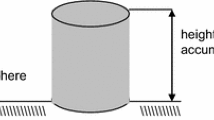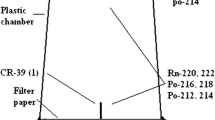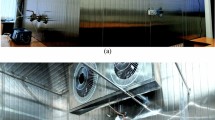Abstract
A simple technique for measurement of the soil-atmosphere radon flux has been developed by fastening a charcoal canister inside a PVC cylindrical container. This device, which is deployed at the ground surface for approximately 16 hours, captures radon emanating from the soil by adsorption onto the charcoal surface. After recovery of the canister and measurement of the radon daughter activity on a NaI detector, the radon flux may be calculated if the adsorption efficiency of radon onto the charcoal is known. This parameter was determined by exposure of charcoal canisters to226Ra-spiked barium palmitate filter sources for timed intervals. Since this compound is known to emanate 100% of the222Rn generated during radium decay, it forms a useful “flux standard.” The accuracy of our flux measurements was assessed by comparison to a more established technique, the enclosed-chamber or “accumulator” method. Concentration measurements were made for the chamber over a less than 2-hour period while the canister flux measurements were based on single overnight deployments. The experiment was repeated 5 times at two different sites and the two techniques generally agreed within a 95% confidence interval.
Similar content being viewed by others
References
N.L. NAGDA, M.D. KOONTZ, R.C. FORTMANN, W.A. SCHOENBORN, L.L. MEHEGAN, Florida Statewide Radiation Study, Final Report to Florida Institute of Phosphate Research, 1987.
W.C. BURNETT, J.B. COWART, W.C. TAI, P.H. CABLE, Investigations of radon and radon daughters in surficial aquifers of Florida, Final report to Florida Institute of Phosphate Research, 133p, 1991.
B.L. COHEN, R. NASON, Health Physics, 50 (1986) 457.
P.H. JENKINS, Health Physics, 57 (1991) 131.
D.J. GRAY, S.T. WINDHAM, NAREL standard operating procedures for radon-222 measurement using diffusion barrier charcoal canisters, EPA 520/5-90-032, 31p.
H. DORR, K.O. MUNNICH, Tellus, 42B (1990) 20.
W. USSLER, J.P. CHANTON, C.A. KELLEY, C.S. MARTENS, Jour. Geophys. Res. 99 (1994) 1953.
P.D. KEARNEY, D.A. KRUEGER, Health Physics, 53 (1987) 525.
C.S. MARTENS, G.W. KIPPIHUT, J. VAL KLUMP, Science 208 (1980) 285.
J.E. PEARSON, Natural environmental radioactivity from radon-222. Public Health Service Publication. No.999-RH-26, 1967.
K. MEGUMI, T. MAMURO, Jour. Geophys. Res. 77 (1972) 3052.
R.J. COUNTESS, Health Physics, 31 (1976) 455.
W.W. NAZAROFF, B.A. MOED, R.G. SEXTRO, Soil as a source of indoor radon: generation, migration, and entry, Chap. 2, in:Radon and Its Decay Products in Indoor Air, W.W. Nazaroff and A. V. NERO (Eds.), John Wiley & Sons, New York, 1988.
T.D. PUGH, J.C. TELOTTE, E.J. DANTIN,Proceedings of the International Symposium on Environmental Contamination in Central and Eastern Europe, Budapest, Hungary (1992).
Author information
Authors and Affiliations
Rights and permissions
About this article
Cite this article
Burnett, W.C., Cable, P.H. & Chanton, J.P. A simple passive collector for direct measurement of radon flux from soil. Journal of Radioanalytical and Nuclear Chemistry, Articles 193, 281–290 (1995). https://doi.org/10.1007/BF02039885
Issue Date:
DOI: https://doi.org/10.1007/BF02039885




